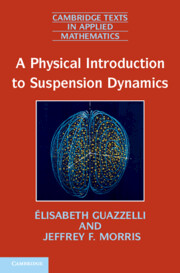Prologue
Published online by Cambridge University Press: 05 June 2012
Summary
Mobile particulate systems are encountered in various natural and industrial processes. In the broadest sense, mobile particulate systems include both suspensions and granular media. Suspensions refer to particles dispersed in a liquid or a gas. Familiar examples include aerosols such as sprays, mists, coal dust, and particulate air pollution; biological fluids such as blood; industrial fluids such as paints, ink, or emulsions in food or cosmetics. Suspension flows are also involved in numerous material processing applications, including manufacture of fiber composites and paper, and in natural processes such as sediment transport in rivers and oceans. In common usage, a suspension refers to solid particles as the dispersed state in a liquid, while an emulsion concerns liquid droplets dispersed in another immiscible fluid, and an aerosol is specific to the case of a suspension of fine solid or liquid particles in a gas. We focus on the case of a suspension in this text.
In the flow of suspensions, the viscous fluid between the particles mediates particle interactions, whereas in dry granular media the fluid between the particles is typically assumed to have a minor role, doing no more than providing a resistive drag, and this allows direct contact interactions. Familiar examples of granular media include dry powders, grains, and pills in the food, pharmaceutical, and agricultural industries; sand piles, dredging, and liquefaction of soil in civil engineering; and geophysical phenomena such as landslides, avalanches, and volcanic eruptions.
- Type
- Chapter
- Information
- A Physical Introduction to Suspension Dynamics , pp. 1 - 6Publisher: Cambridge University PressPrint publication year: 2011



